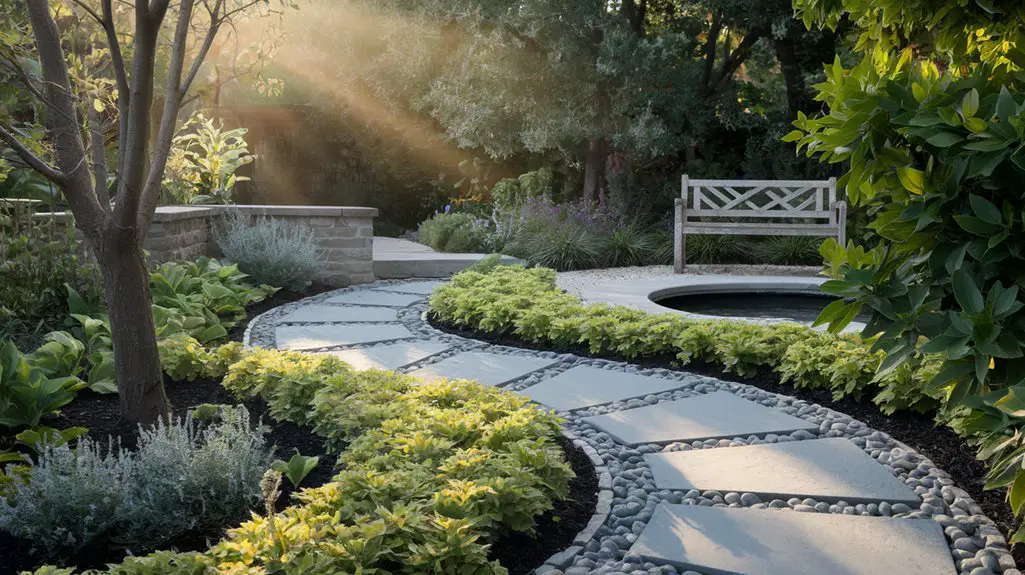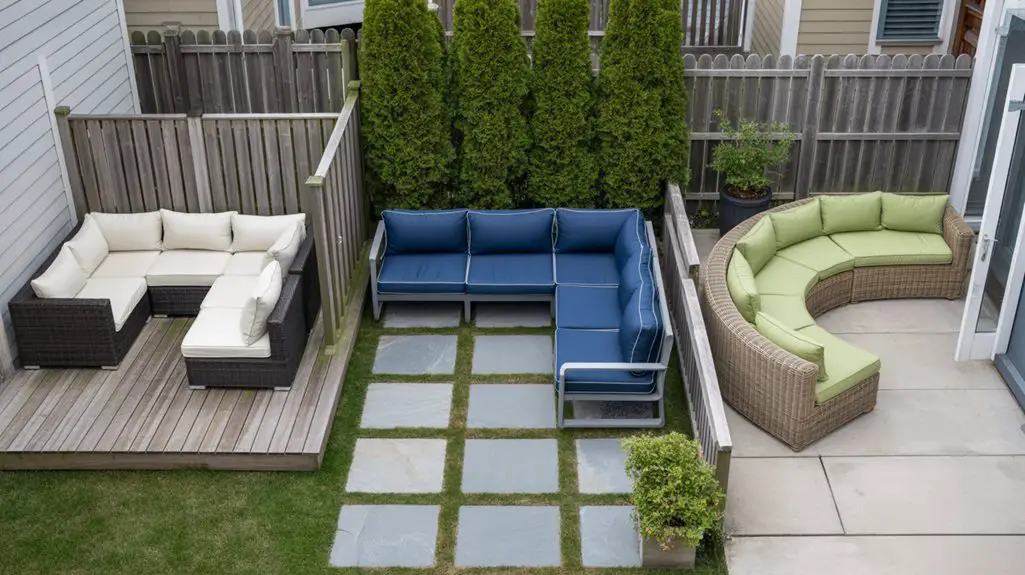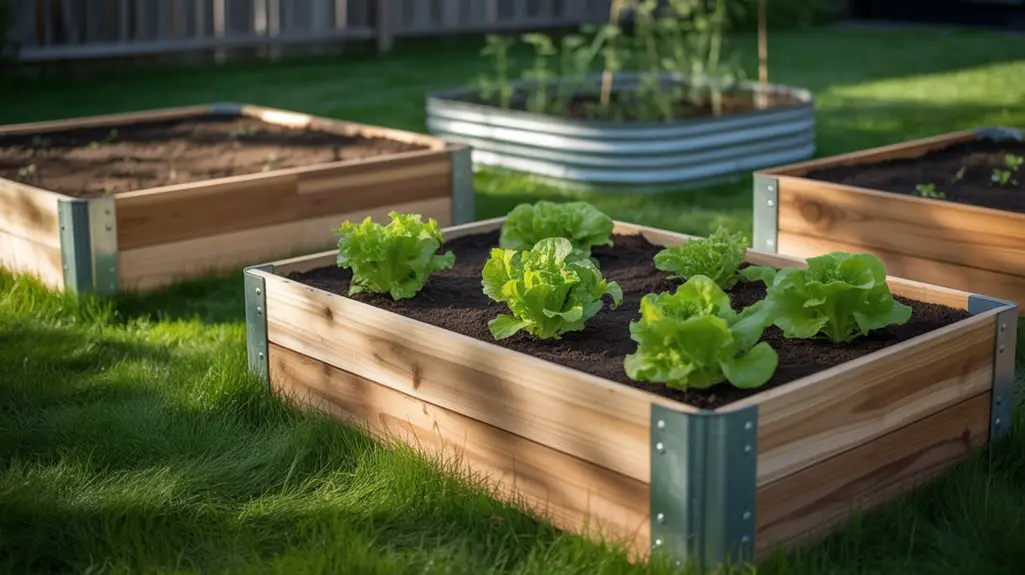Your garden path serves as both a functional thoroughfare and a potential hazard for your four-legged companions. You’ll need to contemplate more than aesthetics when designing these outdoor corridors. From selecting non-toxic plants to choosing paw-friendly materials, each decision affects your pet’s safety and comfort. Creating a path that accommodates both human and animal traffic doesn’t require sacrificing beauty for practicality—the perfect garden path balances both while preventing common pet-related issues.
Choose Non-Toxic Plants Along Pathways
When designing garden paths for homes with pets, selecting non-toxic plants becomes a critical safety measure rather than merely an aesthetic choice. Your curious companions may nibble or brush against vegetation, making plant toxicity a priority consideration.
Replace common toxic plants like lilies, foxglove, and azaleas with pet-safe alternatives. Consider lamb’s ears, catnip, rosemary, and marigolds, which provide sensory interest without health risks. Position these plants as natural borders along your garden paths.
Research each plant’s toxicity profile before purchasing, as some plants have toxic parts while remaining safe otherwise. The ASPCA maintains an extensive database of pet-toxic plants worth consulting. Additionally, utilizing natural pest control methods can help keep harmful insects away without threatening your pet’s safety.
Remember that even non-toxic plants can cause mild digestive upset if consumed in large quantities, so monitor your pet’s behavior around new garden additions.
Select Paw-Friendly Surface Materials
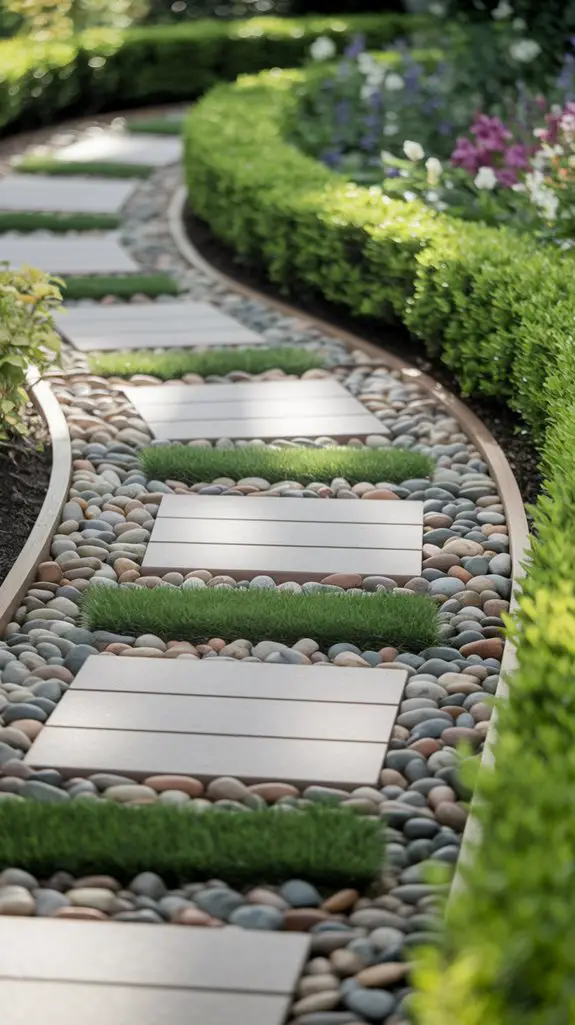
Three essential factors determine whether a garden path material is suitable for your pets: texture, temperature regulation, and toxicity profile. Smooth pebbles, natural flagstone, and packed earth provide comfortable surfaces that won’t abrade sensitive paw pads or trap sharp debris.
Avoid dark-colored materials like black rubber mulch or asphalt, which absorb heat and can burn paws during summer months. Instead, select light-colored decomposed granite or wood chips that remain cool even in direct sunlight.
Ensure all materials are untreated and chemical-free. Cedar mulch releases oils potentially harmful to dogs, while cocoa mulch contains theobromine, toxic to both cats and dogs. Opt for pine straw or untreated hardwood mulch as safer alternatives. Additionally, using pet-safe alternatives can significantly reduce the risk of accidental harm to your furry friends.
For maximum comfort, combine materials strategically—perhaps stone in shaded areas and cooler substances where sun exposure is highest.
Create Wide Paths for Side-by-Side Walks
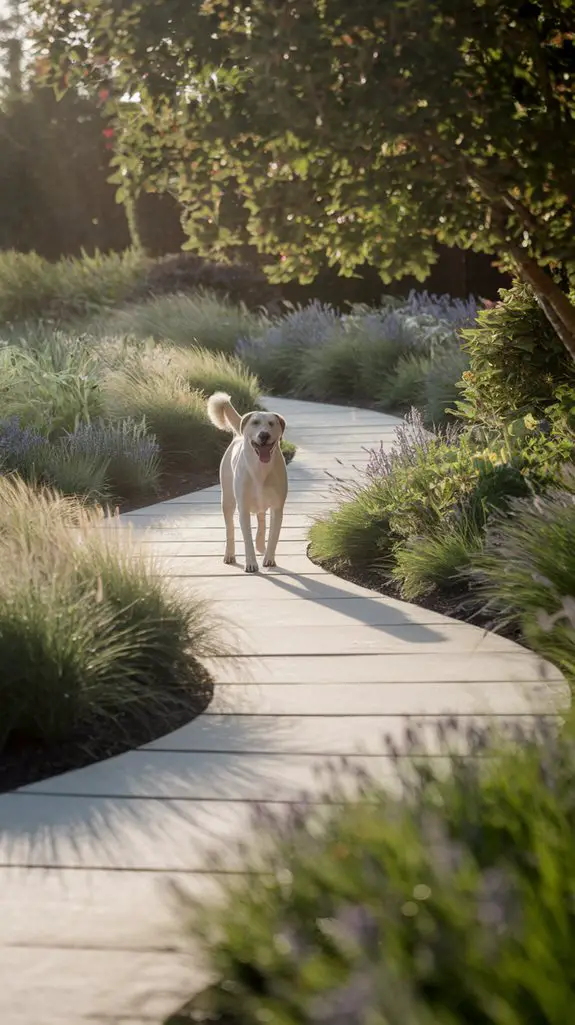
While designing your garden layout, make certain paths measure at least 4-5 feet wide to accommodate both you and your four-legged companions walking comfortably side by side. Narrow paths force pets to trail behind or rush ahead, increasing the risk of trampled plants and anxious animals. Additionally, incorporating creative pathways can enhance the overall aesthetic while providing a safe environment for your pets.
| Path Width | Benefits | Pet Considerations | Plant Protection |
|---|---|---|---|
| 3 feet | Space-efficient | Single-file only | High trampling risk |
| 4 feet | Comfortable duo walking | Medium dogs alongside | Moderate buffer zone |
| 5 feet | Spacious experience | Large dogs with room | Ample plant protection |
| 6+ feet | Group walking possible | Multiple pets safely | Maximum vegetation safety |
Consider incorporating occasional wider “passing zones” along narrower sections where space constraints exist. These strategic widenings prevent bottlenecks and allow for smooth navigation during those inevitable moments when your pet stops to investigate an enticing scent.
Install Proper Drainage to Prevent Muddy Paws
Installing proper drainage throughout your garden paths prevents the frustrating cycle of muddy paws tracking through your home after every rainfall. Incorporate a slight crown to your path design, allowing water to shed toward the edges rather than pooling in the center where pets walk.
Layer a 4-inch base of crushed stone beneath your path material to facilitate water movement downward. For areas prone to standing water, install French drains alongside paths—these gravel-filled trenches with perforated pipes redirect excess moisture away from walking surfaces.
Consider bordering paths with moisture-loving plants like ferns or astilbe that absorb runoff. Additionally, integrating native plants into your garden can enhance the habitat for local wildlife while providing a natural aesthetic.
Remember that proper drainage not only keeps paws clean but also prevents paw pad infections from constant moisture exposure. Quick-drying surfaces like decomposed granite or flagstone set in sand provide excellent permeability while remaining comfortable for sensitive paws.
Design Gentle Slopes Instead of Stairs
Gentle slopes offer significant advantages over traditional stairs in pet-friendly garden paths, especially for aging dogs, short-legged breeds, and small animals. They replicate natural terrain while reducing joint strain and potential injuries from missteps or tumbles that stairs often cause. Additionally, incorporating a backyard stage can create an engaging environment where pets can comfortably explore and enjoy their surroundings.
When incorporating slopes into your garden design:
- Maintain a gradient between 5-8% (rising 5-8 inches per 10 feet) to guarantee comfortable navigation for arthritic pets.
- Install textured surfaces like fine gravel or specialized non-slip pavers that provide traction in all weather conditions.
- Border slopes with low-growing, non-toxic plants such as creeping thyme or Irish moss to visually define the path’s edges without creating hazards.
You’ll notice your pets naturally prefer these gradual changes, demonstrating more confident movement throughout your garden landscape.
Incorporate Shaded Rest Areas
As pets navigate your garden paths, strategic shaded rest areas become essential sanctuaries that protect them from heat exhaustion and sunburn during outdoor exploration. Position these cooling zones every 20-30 feet along your path system, especially in south-facing exposures.
| Rest Area Type | Benefits | Best For |
|---|---|---|
| Pergola with vines | Dense shade, cooling effect | Dogs, cats, rabbits |
| Stone bench under tree | Natural shelter, ground cooling | Larger dogs, multiple pets |
| Miniature pet gazebo | Wind protection, rain cover | Small breeds, senior pets |
Select plants like hostas and ferns for these areas—they’re non-toxic to animals and thrive in shade. Install shallow water features that won’t become breeding grounds for mosquitoes. Remember, stone and concrete surfaces can retain heat, so incorporate cooling materials like mulch or specialized pet-friendly turf. Additionally, incorporating non-toxic plants not only provides shade but also enhances your garden’s aesthetic appeal.
Avoid Sharp Edging Materials
While rest areas offer comfort for your pets, the materials that define your garden paths demand equal attention for safety. Sharp-edged path borders can lacerate paw pads or cause painful abrasions when pets run through your garden.
Select rounded, smooth-edged materials that won’t puncture delicate paws or scrape against sensitive skin.
- Replace metal edging with alternatives like rounded concrete curbing, smooth river rocks, or flexible polymer borders that bend rather than cut when impacted.
- Avoid cocoa mulch edging which contains theobromine—toxic to dogs and cats—and opt for pine straw or cedar mulch instead.
- Consider densely-planted ground covers like creeping thyme or Irish moss as living borders that eliminate hard edges while defining path boundaries. Additionally, incorporating soft landscaping materials can further enhance the safety and comfort of your pet’s play area.
Plan Strategic Bathroom Zones
Creating designated bathroom zones in your garden prevents random elimination across prized plantings and reduces the frustration of discovering yellow spots on your lawn.
Select a discreet corner with permeable substrate like pea gravel or wood chips that effectively absorbs urine and allows for easy waste removal.
Install vertical markers such as sturdy posts or dedicated “pee poles” that trigger your dog’s natural territory-marking instincts. For felines, integrate a small sandpit with loose, diggable material.
Border these zones with scent-attracting plants like catnip or dog mint to naturally draw pets to their designated areas.
Maintain these zones by removing solid waste promptly and periodically rinsing gravel with enzymatic cleaners to neutralize odors. This targeted approach preserves your garden’s aesthetics while accommodating your pets’ natural behaviors, and selecting appropriate privacy fencing can further enhance your pets’ sense of security in these areas.
Establish Boundary Indicators for Garden Beds
Clear visual boundaries serve as essential communication tools between you and your pets, preventing accidental trampling or digging in prized garden beds.
Implement physical indicators that your four-legged companions can easily recognize and respect while maintaining garden aesthetics.
- Install low decorative fencing (8-12 inches high) of cedar, bamboo, or powder-coated metal around sensitive plantings—the physical barrier deters entry while providing visual cues your pet will understand.
- Create gravel or mulch perimeters around beds, using materials that differ texturally from your paths—many animals avoid crossing these change zones due to unfamiliar paw sensations.
- Plant pet-deterrent border species like lavender, rosemary, or coleus canina (“scaredy cat plant”), whose strong scents naturally discourage animal intrusion while enhancing your garden’s sensory appeal. Additionally, consider incorporating creative privacy screens that not only define space but also contribute to a peaceful environment for your pets.
Balance Durable Materials With Natural Aesthetics
The ideal pet-friendly garden path strikes a delicate balance between durability that withstands paw traffic and natural elements that blend harmoniously with your landscape.
Consider flagstone or slate pavers set in sand rather than concrete—they provide stable footing for paws while allowing water drainage and subtle plant growth between stones. Decomposed granite compacts well for mobility-impaired pets, while avoiding the heat retention of concrete that can burn sensitive paw pads. Edge your paths with pet-friendly plants to enhance the natural look and provide a safe environment for your furry friends. Incorporating eco-friendly options can further ensure that your garden path is sustainable and beneficial for the ecosystem.
Conclusion
Your perfectly planned pathway provides a pleasing paradise for both pets and plants. You’ll witness wagging tails and contented companions as they traverse the thoughtfully textured terrain. With proper drainage preventing paw problems and sufficient space supporting side-by-side strolls, your garden becomes a harmonious habitat. Remember, rounded edges reduce risks while strategic zones satisfy natural needs. Your garden now nurtures nature’s balance between botanical beauty and animal accessibility.

